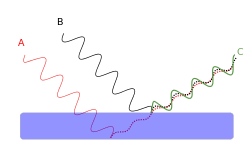
Thin interference film happens with
This is a multiple choice question
A. point or spherical source
B. Board source
C. Film thickness of order 10,000 Å
D. Very thick transparent slabs
Answer
539.7k+ views
Hint: Thin film interference occurs when light waves reflect the top and bottom of a top and bottom of a thin film interface. The waves of light must interfere constructively for this phenomenon to happen.
Complete step by step answer:
When a wave reaches the boundary between two media, a portion is transmitted across the boundary and a portion is reflected off the boundary. The transmitted portion travels through the medium until it reaches a new medium which is a thin film. If it’s a thin film, the wave undergoes the same reflection and transmission process.

The two waves coming out must have a constructive interface.
There could be two ways they interfere constructively, one is they are relatively close to each other and their crests and troughs meet up, the other is they must form crests and troughs at the same time and location.
Therefore, the answers are the sources must be broad and the thickness of film must be of order of 10,000Å as we require constructive interference.
Hence, the correct answer is option Band C.
Additional Information
During a rainy day, we can observe a colorful interference pattern when light is reflected from the top and bottom boundaries of an oil film. The difference in bands is due to the diminishing in film’s thickness gradually as we go from center to boundaries. We can also observe this on a soap bubble where light is projected on it. This phenomenon has many applications like ellipsometry, dual polarization interferometry etc.
Note:
A point source would give light spherically or in a bubble manner, in this case the two waves cannot meet. If the film thickness is high, it would be difficult for the two waves to meet constructively. Or there's a high chance of destructive interference.
Complete step by step answer:
When a wave reaches the boundary between two media, a portion is transmitted across the boundary and a portion is reflected off the boundary. The transmitted portion travels through the medium until it reaches a new medium which is a thin film. If it’s a thin film, the wave undergoes the same reflection and transmission process.

The two waves coming out must have a constructive interface.
There could be two ways they interfere constructively, one is they are relatively close to each other and their crests and troughs meet up, the other is they must form crests and troughs at the same time and location.
Therefore, the answers are the sources must be broad and the thickness of film must be of order of 10,000Å as we require constructive interference.
Hence, the correct answer is option Band C.
Additional Information
During a rainy day, we can observe a colorful interference pattern when light is reflected from the top and bottom boundaries of an oil film. The difference in bands is due to the diminishing in film’s thickness gradually as we go from center to boundaries. We can also observe this on a soap bubble where light is projected on it. This phenomenon has many applications like ellipsometry, dual polarization interferometry etc.
Note:
A point source would give light spherically or in a bubble manner, in this case the two waves cannot meet. If the film thickness is high, it would be difficult for the two waves to meet constructively. Or there's a high chance of destructive interference.
Recently Updated Pages
Master Class 12 Business Studies: Engaging Questions & Answers for Success

Master Class 12 Economics: Engaging Questions & Answers for Success

Master Class 12 English: Engaging Questions & Answers for Success

Master Class 12 Maths: Engaging Questions & Answers for Success

Master Class 12 Social Science: Engaging Questions & Answers for Success

Master Class 12 Chemistry: Engaging Questions & Answers for Success

Trending doubts
Which are the Top 10 Largest Countries of the World?

What is transplantation in agriculture class 12 biology CBSE

Differentiate between homogeneous and heterogeneous class 12 chemistry CBSE

Why is the cell called the structural and functional class 12 biology CBSE

Hydrological cycle is controlled by A Grasslands B class 12 biology CBSE

Who discovered the cell and how class 12 biology CBSE




